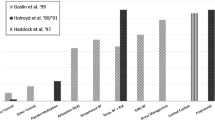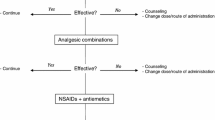Abstract
Interest in nonpharmacologic interventions for chronic tension-type headache has increased in recent years, with many professional organizations recommending behavioral treatments such as relaxation training, biofeedback, and cognitive-behavioral therapy alongside pharmacologic treatments. Although the efficacy of behavioral interventions is well-documented, several potential barriers in dissemination and implementation exist that have precluded more widespread adoption of behavioral treatments. This article briefly reviews the core components and efficacy of behavioral treatments for tension-type headache and outlines challenges to their broader clinical use as they occur at the levels of empirical research, treatment availability and delivery, and common clinical problems. Strategies for addressing these challenges are suggested, and directions for needed research are noted.
Similar content being viewed by others
References and Recommended Reading
Peatfield RC, Edmeads JG: General approach to treatment of tension-type headaches. In The Headaches, edn 3. Edited by Olesen J, Goadsby PJ, Ramadan NM, et al.: Philadelphia: Lippincott Williams & Wilkins; 2006:707–709.
The Robert Wood Johnson Foundation: Chronic Care in America: A 21st Century Challenge. San Francisco: The Institute for Health and Aging, University of California; 1996.
Penzien DB, Rains JC, Lipchik GL, Creer TL: Behavioral interventions for tension-type headache: overview of current therapies and recommendation for a self-management model for chronic headache. Curr Pain Headache Rep 2004, 8:489–499.
Holroyd KA, Martin PR, Nash JM: Psychological treatments of tension-type headaches. In The Headaches, edn 3. Edited by Olesen J, Goadsby PJ, Ramadan NM, et al.: Philadelphia: Lippincott Williams & Wilkins; 2006:711–719.
Nash JM: Psychologic and behavioral management of tension-type headache: treatment procedures. Curr Pain Headache Rep 2003, 2:475–481.
Rains JC, Penzien DB, McCrory DC, Gray RN: Behavioral headache treatment: history, review of the empirical literature, and methodological critique. Headache 2005, 45(Suppl 2):S91–S108.
McCrory DC, Penzien DB, Hasselblad V, Gray RN: Evidence Report: Behavioral and Physical Treatments for Tension-type and Cervicogenic Headache. Des Moines, IA: Foundation for Chiropractic Education and Research; 2001.
Söderberg E, Carlsson J, Stener-Victorin E: Chronic tension-type headache treated with acupuncture, physical training and relaxation training. Between-group differences. Cephalalgia 2006, 26:1320–1329.
Bogaards MC, ter Kuile MM: Treatment of recurrent tension headache: a meta-analytic review. Clin J Pain 1994, 10:174–190.
Holroyd KA, Penzien DB: Client variables and the behavioral treatment of recurrent tension headache: a meta-analytic review. J Behav Med 1986, 9:515–536.
Penzien DB, Rains JC, Lipchik GL, et al.: Future directions in behavioral headache research: applications for an evolving healthcare environment. Headache 2005, 45:526–534.
Headache Classification Committee of the International Headache Society: Classification and diagnostic criteria for headache disorders, cranial neuralgias and facial pain. Cephalalgia 1988, 8(Suppl 7):1–96.
Headache Classification Subcommittee of the International Headache Society: The International Classification of Headache Disorders: 2nd edition. Cephalalgia 2004, 24(Suppl 1):1–160.
Rains JC, Penzien DB: Behavioral research and the double-blind placebo-controlled methodology: challenges in applying the biomedical standard to behavioral headache research. Headache 2005, 45:479–486.
Penzien DB, Andrasik F, Freidenberg BM, et al.: Guidelines for trials of behavioral treatments for recurrent headache. Headache 2005, 45(Suppl 2):S109–S131.
Mulkana SS, Penzien DB, Houle TT, et al.: Expense of preventative drug and behavioral headache therapies: an expanded analysis. Headache 2004, 44:515.
Penzien DB, Rains JC, Andrasik F: Behavioral management of recurrent headache: three decades of experience and empiricism. Appl Psychophysiol Biofeedback 2002, 27:163–181.
Breslau N: Psychiatric comorbidity in migraine. Cephalalgia 1998, 18(Suppl 22):S56–S61.
Hamelsky SW, Lipton RB: Psychiatric comorbidity of migraine. Headache 2006, 46:1327–1333.
Lake AE, Lipchik GL, Penzien DB, et al.: Psychiatric comorbidity with chronic headache: evidence-based clinical implications—introduction to the supplement. Headache 2006, 46(Suppl 3):S73–S75.
Penzien, DB, Peatfield RC, Lipchik GL: Headache in patients with co-morbid psychiatric disease. In The Headaches, edn 3. Edited by Olesen J, Goadsby P, Ramadan N, et al.: Philadelphia: Lippincott Williams & Wilkins; 2006:1117–1124.
Penzien DB, Rains JC, Lake AE, et al.: Complex comorbidities of recurrent headache disorders: introduction to the special series. Headache 2006, 46:1324–1326.
Zwart JA, Dyb G, Hagen K, et al.: Depression and anxiety disorders associated with headache frequency. The Nord-Trøndelag Health Study. Eur J Neurol 2003, 10:147–152.
Guidetti V, Galli F, Fabrizi P, et al.: Headache and psychiatric comorbidity: clinical aspects and outcome in an 8-year follow-up study. Cephalalgia 1998, 18:455–462.
Lantéri-Minet M, Radat F, Chautart MH, Lucas C: Anxiety and depression associated with migraine: influence on migraine subjects’ disability and quality of life, and acute migraine management. Pain 2005, 118:319–326.
Pesa J, Lage MJ: The medical costs of migraine and comorbid anxiety and depression. Headache 2004, 44:562–570.
Heckman BD, Holroyd KA: Tension-type headache and psychiatric comorbidity. Curr Pain Headache Rep 2006, 10:439–447.
Mongini F, Rota E, Deregibus A, et al.: A comparative analysis of personality profile and muscle tenderness between chronic migraine and chronic tension-type headache. Neurol Sci 2005, 26:203–207.
Holroyd KA, Stensland M, Lipchik GL, et al.: Psychosocial correlates and impact of chronic tension-type headaches. Headache 2000, 40:3–16.
Maizels, M, Smitherman TA, Penzien DB: A review of screening tools for psychiatric comorbidity in headache patients. Headache 2006, 46(Suppl 3):S98–S109.
Kroenke K, Spitzer RL, Williams JB: The PHQ-9: validity of a brief depression screening measure. J Gen Intern Med 2001, 16:606–613.
Spitzer RL, Kroenke K, Williams JBW, Löwe B: A brief measure for assessing generalized anxiety disorder. Arch Intern Med 2006, 166:1092–1097.
Lipchik GL, Smitherman TA, Penzien DB, Holroyd K: Basic principles and techniques of cognitive-behavioral therapies for comorbid psychiatric symptoms among headache patients. Headache 2006, 46(Suppl 3):S119–S132.
Rains JC, Poceta JS: Headache and sleep disorders: review and clinical implications for headache management. Headache 2006, 46:1344–1363.
Lynberg AC, Rasmussen BK, Jorgensen T, Jensen R: Incidence of primary headache: a Danish epidemiologic follow up study. Am J Epidemiol 2005, 161:1066–1073.
Spierings EL, van Hoof MJ: Fatigue and sleep in chronic headache sufferers: an age-and sex-controlled questionnaire study. Headache 1997, 37:549–552.
Rothrock J, Patel M, Lyden P, Jackson C: Demographic and clinical characteristics of patients with episodic migraine versus chronic daily headache. Cephalalgia 1996, 16:44–49.
Lake AE, Saper JR, Madden SF, Kreeger C: Comprehensive inpatient treatment for intractable migraine: a prospective long-term outcome study. Headache 1993, 33:55–62.
Hoodin F, Brines BJ, Lake AE, et al.: Behavioral self-management in an inpatient headache treatment unit: increasing adherence and relationship to changes in affective distress. Headache 2000, 40:377–383.
Calhoun AH, Ford S: Behavioral sleep modifications may revert transformed migraine to episodic migraine. Headache 2007, 47:1178–1183.
Michultka DM, Blanchard EB, Appelbaum KA, et al.: The refractory headache patient: II. High medication consumption (analgesic rebound) headache. Behav Res Ther 1989, 27:411–420.
Pascual J, Colas R, Castillo J: Epidemiology of chronic daily headache. Curr Pain Headache Rep 2001, 5:529–536.
Dodick D, Freitag F: Evidence-based understanding of medication-overuse headache: clinical implications. Headache 2006, 46(Suppl 4):S202–S211.
Rains JC, Lipchik GL, Penzien DB: Behavioral facilitation of medical treatment for headache—part 1: review of headache treatment compliance. Headache 2006, 46:1387–1394.
Rains JC, Penzien DB, Lipchik GL: Behavioral facilitation of medical treatment for headache—part 2: theoretical models and behavioral strategies for improving adherence. Headache 2006, 46:1395–1403.
Rains JC, Penzien DB, Lipchik GL: Behavioral facilitation of medical treatment of headache: implications of noncompliance and strategies for improving adherence. Headache 2006, 46(Suppl 3):S142–S143.
Grazzi L, Andrasik F, D’Amico D, et al.: Behavioral and pharmacologic treatment of transformed migraine with analgesic overuse: outcome at 3 years. Headache 2002, 42:483–490.
Holroyd KA, O’Donnell FJ, Stensland M, et al.: Management of chronic tension-type headache with tricyclic antidepressant medication, stress management therapy, and their combination: a randomized controlled trial. JAMA 2001, 285:2208–2215.
Holroyd K, Cottrell C, Drew J, et al.: Preventive medication, behavioral migraine management and their combination: effects on migraine self-management. Headache 2007, 47:795.
Burns DD, Spangler DL: Does psychotherapy homework lead to improvements in depression in cognitive-behavioral therapy or does improvement lead to increased homework compliance? J Consult Clin Psychol 2001, 69:1079–1083.
Persons JB, Burns DD, Perloff JM: Predictors of dropout and outcome in cognitive therapy for depression in a private practice setting. Cognit Ther Res 1988, 12:557–575.
Author information
Authors and Affiliations
Corresponding author
Rights and permissions
About this article
Cite this article
Smitherman, T.A., Penzien, D.B. & Rains, J.C. Challenges of nonpharmacologic interventions in chronic tension-type headache. Current Science Inc 11, 471–477 (2007). https://doi.org/10.1007/s11916-007-0236-y
Published:
Issue Date:
DOI: https://doi.org/10.1007/s11916-007-0236-y




